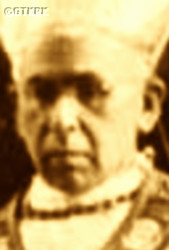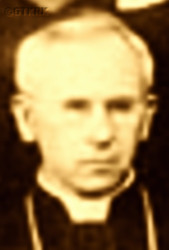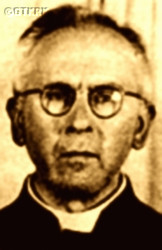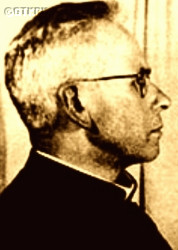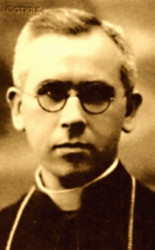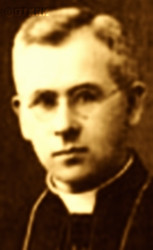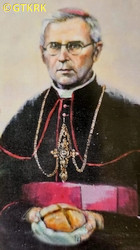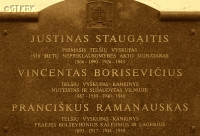Roman Catholic
St Sigismund parish
05-507 Słomczyn
85 Wiślana Str.
Konstancin deanery
Warsaw archdiocese, Poland
full list:
displayClick to display full list

searchClick to search full list by categories
wyświetlKliknij by wyświetlić pełną listę po polsku

szukajKliknij by przeszukać listę wg kategorii po polsku

Martyrology of the clergy — Poland
XX century (1914 – 1989)
personal data
surname
BORUSEWICZ
surname
versions/aliases
BORISEVIČIUS, BORYSEWICZ
forename(s)
Vincent (pl. Wincenty)
forename(s)
versions/aliases
Vincentas
function
bishop
creed
Latin (Roman Catholic) Church RCmore on
en.wikipedia.org
[access: 2014.09.21]
diocese / province
Telsiai diocesemore on
en.wikipedia.org
[access: 2014.12.20]
Sejny diocesemore on
www.catholic-hierarchy.org
[access: 2021.12.19]
RC Military Ordinariate of Polandmore on
en.wikipedia.org
[access: 2014.12.20]
academic distinctions
Bachelor of Sacred Theology
honorary titles
pontifical prelatemore on
pontifical prelate
(16.02.1928)
Cross of Vytis (Lithuania) — Commander's Grand 2nd Classmore on
Cross of Vytis (Lithuania) – Commander's Grand 2nd Class
(24.09.1999)
nationality
Lithuanian
date and place
of death
18.11.1946

Vilniustoday: Vilnius city dist., Vilnius Cou., Lithuania
more on
en.wikipedia.org
[access: 2022.01.06]
details of death
During World War I, during a short lived occupation in 1914 of Kalvarija by the Germans helf for some time prisoner as hostage.
Facing another German offensive in 1915 escaped to Minsk (during so‐called bezhenstvo, a panic escape of c. 3 mln Russians — imperial, military officials, teachers — from Russian occupied Poland and Lithuania), where in 1916‐1917 was military chaplain of 10th Russian Imperial Army.
After start of German occupation of Minsk on 21.02.1918 taught religion in local gymnasium.
After German and Russian invasion of Poland in 09.1939 and start of the World War II, after start in 1941 of German occupation, prob. helped to hide persecuted Jews.
After start in 1944 of the second Russian occupation arrested by the Russian genocidal NKVD on 18.12.1945.
Jailed in Vilnius prison.
Refused to cooperate with NKVD.
Released after six days but on 05.02.1946 arrested again.
And again held in Vilnius prison.
Tortured — interrogated for 12‐15 hours without a break.
Accused of „treason of the homeland, collaboration with anti–Russian partisans, anti–Russian activities and propaganda” (the sources list: „delivering anti–Russian sermons in 1940‐1941” — i.e. during first Russian occupation of Lithuania; „harboring of anti–Russian books” — e.g. „the eyewitness account of the Chervyen massacre perpetrated by the Russians”; „publishing an anti–Russian proclamation in 1943”; „supporting the [anti–Russian, clandestine] Lithuanian Freedom Army, and helping to hide its leaders”; „providing Lithuanian partisans with fake papers”; and „helping a German paratrooper transmit a radiogram to Germany”).
On 28.08.1946 sentenced to death.
Imprisoned in Lukiškės prison in Vilnius.
Murdered in Vilnius prison — prob. in NKVD/MGB HQs at Lukiškės Square, and buried in a mass grave in Tuskulanum palace (in Žirmūnai part of Vilnius).
cause of death
mass murder
perpetrators
Russians
sites and events
Vilnius (Tuskulanum)Click to display the description, Vilnius (Łuskis Square)Click to display the description, Vilnius (Lukiškės)Click to display the description, Ribbentrop‐MolotovClick to display the description, Pius XI's encyclicalsClick to display the description
date and place
of birth
23.11.1887

Bebrininkaitoday: Pilviškiai eld., Vilkaviškis dist., Marijampolė Cou., Lithuania
more on
lt.wikipedia.org
[access: 2020.07.31]
parents
BORUSEWICZ Augustine
🞲 ?, ? — 🕆 08.11.1917, ?

RUGIENIŪTĖ Mary
🞲 ?, ? — 🕆 11.01.1894, ?
presbyter (holy orders)
ordination
29.05.1910

Fribourgtoday: Fribourg can., Switzerland
more on
en.wikipedia.org
[access: 2021.07.25]
positions held
1944 – 1946
bishop — Telšiai RC diocese — appointment: on 21.01.1944
1940 – 1944
titular bishop — Lysias RC diocese — appointment: on 03.02.1940; ordination: on 10.03.1940 in Telšiai cathedral
1940 – 1944
auxiliary bishop (Lat. episcopus auxiliaris) — Telšiai RC diocese — appointment: on 03.02.1940
1926 – 1940
rector — Telšiaitoday: Telšiai urban eld., Telšiai dist., Telšiai Cou., Lithuania
more on
en.wikipedia.org
[access: 2022.01.06] ⋄ philosophy and theology, Theological Seminary — also: professor of moral theology
1922 – 1926
professor — Gižaitoday: Gižai eld., Vilkaviškis dist., Marijampolė Cou., Lithuania
more on
lt.wikipedia.org
[access: 2022.02.03] ⋄ Theological Seminary ⋄ Sejny (Lithuanian part) RC diocese — lecturer of moral and pastoral theology and social science
1921 – 1922
student — Fribourgtoday: Fribourg can., Switzerland
more on
en.wikipedia.org
[access: 2021.07.25] ⋄ philosophy and theology, Lat. Universitas Friburgensis (Eng. University of Fribourg) — continuation of postgraduate specialised studies, with the intention of obtaining a doctoral degree
1918 – 1921
prefect — Marijampolėtoday: Marijampolė eld., Marijampolė dist., Marijampolė Cou., Lithuania
more on
en.wikipedia.org
[access: 2020.11.13] ⋄ Gymnasium and Real–gymnasium (till 1919) ⋄ St Michael the Archangel RC parish ⋄ Marijampolėtoday: Marijampolė eld., Marijampolė dist., Marijampolė Cou., Lithuania
more on
en.wikipedia.org
[access: 2020.11.13] RC deanery
1920
chairman — Marijampolėtoday: Marijampolė eld., Marijampolė dist., Marijampolė Cou., Lithuania
more on
en.wikipedia.org
[access: 2020.11.13] ⋄ City Council
1918
prefect — Minsktoday: Minsk city reg., Belarus
more on
en.wikipedia.org
[access: 2020.07.31] ⋄ gymnasium(s) ⋄ Holy Name of Blessed Virgin Mary RC cathedral parish ⋄ Minsktoday: Minsk city reg., Belarus
more on
en.wikipedia.org
[access: 2020.07.31] RC deanery
1916 – 1917
RC military chaplain — Minsktoday: Minsk city reg., Belarus
more on
en.wikipedia.org
[access: 2020.07.31] ⋄ Rus. 10–я армия (Eng. 10th Army), Imperial Russian Army
1913 – 1915
vicar — Kalvarijatoday: Kalvarija eld., Marijampolė dist., Marijampolė Cou., Lithuania
more on
en.wikipedia.org
[access: 2022.06.29] ⋄ Name of the Blessed Virgin Mary RC parish ⋄ Kalvarijatoday: Kalvarija eld., Marijampolė dist., Marijampolė Cou., Lithuania
more on
en.wikipedia.org
[access: 2022.06.29] RC deanery — also: prison chaplain
1909 – 1910
student — Fribourgtoday: Fribourg can., Switzerland
more on
en.wikipedia.org
[access: 2021.07.25] ⋄ philosophy and theology, Lat. Universitas Friburgensis (Eng. University of Fribourg) — postgraduate specialised studies, crowned with a Sacred Theology Bachelor's degree
1903 – 1909
student — Sejnytoday: Sejny urban gm., Sejny pov., Podlaskie voiv., Poland
more on
en.wikipedia.org
[access: 2022.01.28] ⋄ philosophy and theology, Theological Seminary
others related
in death
GUSTAITISClick to display biography Francis, TAPPERClick to display biography Nicholas, BALČIŪNASClick to display biography Vladislav, BEINORAVIČIUSClick to display biography Boleslav, STASEVIČIUSClick to display biography Adolph
sites and events
descriptions
Vilnius (Tuskulanum): A palace with a surrounding garden in Żyrmunty quarters in Vilnius where in 1940s Russians secretely buried in mass graves bodies of murdered Polish soldiers of resistance Home Army AK (part of Polish Clandestine State), Lithuanian partisans and German collaborators, captured by the genocidal Russian NKVD/MGB organization. In 1990. c. 706 bodies were discovered in the palace. (more on: en.wikipedia.orgClick to attempt to display webpage
[access: 2017.06.16])
Vilnius (Łuskis Square): In the former Tsarist prison and 1918‐1939 Polish Republic voivodeship buildings at Łukiski Square (Ofiarna Str.) Germans in 1941 set up the Gestapo HQ and jail and Russians in 1944 the Vilnius HQ of the genocidal NKVD/MGB organisation. Thousands of Polish soldiers of resistance Home Army AK (part of Polish Clandestine State), Lithuanian partisans and during Russian occupation after 1944 — German collaborators were interrogated and tortured there. In the basements death sentences were carried out. In 1944‐1960 alone Russians carried out more then 1,000 death sentences there — some of the bodies were secretely buried in a nearby Tuskulanum palace in Vilnius. (more on: en.wikipedia.orgClick to attempt to display webpage
[access: 2017.06.16])
Vilnius (Lukiškės): Vilnius prison used both by Russians and Germans. Thousands of Poles were kept there. From 2,000 to 16,000 prisoners were jailed at any time there. In 06.1941, after German invasion, Russians murdered most of the prisoners. (more on: en.wikipedia.orgClick to attempt to display webpage
[access: 2021.07.04])
Ribbentrop‐Molotov: Genocidal Russian‐German alliance pact between Russian leader Joseph Stalin and German leader Adolf Hitler signed on 23.08.1939 in Moscow by respective foreign ministers, Mr. Vyacheslav Molotov for Russia and Joachim von Ribbentrop for Germany. The pact sanctioned and was the direct cause of joint Russian and German invasion of Poland and the outbreak of the World War II in 09.1939. In a political sense, the pact was an attempt to restore the status quo ante before 1914, with one exception, namely the „commercial” exchange of the so‐called „Kingdom of Poland”, which in 1914 was part of the Russian Empire, fore Eastern Galicia (today's western Ukraine), in 1914 belonging to the Austro‐Hungarian Empire. Galicia, including Lviv, was to be taken over by the Russians, the „Kingdom of Poland” — under the name of the General Governorate — Germany. The resultant „war was one of the greatest calamities and dramas of humanity in history, for two atheistic and anti‐Christian ideologies — national and international socialism — rejected God and His fifth Decalogue commandment: Thou shall not kill!” (Abp Stanislav Gądecki, 01.09.2019). The decisions taken — backed up by the betrayal of the formal allies of Poland, France and Germany, which on 12.09.1939, at a joint conference in Abbeville, decided not to provide aid to attacked Poland and not to take military action against Germany (a clear breach of treaty obligations with Poland) — were on 28.09.1939 slightly altered and made more precise when a treaty on „German‐Russian boundaries and friendship” was agreed by the same murderous signatories. One of its findings was establishment of spheres of influence in Central and Eastern Europe and in consequence IV partition of Poland. In one of its secret annexes agreed, that: „the Signatories will not tolerate on its respective territories any Polish propaganda that affects the territory of the other Side. On their respective territories they will suppress all such propaganda and inform each other of the measures taken to accomplish it”. The agreements resulted in a series of meeting between two genocidal organization representing both sides — German Gestapo and Russian NKVD when coordination of efforts to exterminate Polish intelligentsia and Polish leading classes (in Germany called «Intelligenzaktion», in Russia took the form of Katyń massacres) where discussed. Resulted in deaths of hundreds of thousands of Polish intelligentsia, including thousands of priests presented here, and tens of millions of ordinary people,. The results of this Russian‐German pact lasted till 1989 and are still in evidence even today. (more on: en.wikipedia.orgClick to attempt to display webpage
[access: 2015.09.30])
Pius XI's encyclicals: Facing the creation of two totalitarian systems in Europe, which seemed to compete with each other, though there were more similarities than contradictions between them, Pope Pius XI issued in 03.1937 (within 5 days) two encyclicals. In the „Mit brennender Sorge” (Eng. „With Burning Concern”) published on 14.03.1938, condemned the national socialism prevailing in Germany. The Pope wrote: „Whoever, following the old Germanic‐pre‐Christian beliefs, puts various impersonal fate in the place of a personal God, denies the wisdom of God and Providence […], whoever exalts earthly values: race or nation, or state, or state system, representatives of state power or other fundamental values of human society, […] and makes them the highest standard of all values, including religious ones, and idolizes them, this one […] is far from true faith in God and from a worldview corresponding to such faith”. On 19.03.1937, published „Divini Redemptoris” (Eng. „Divine Redeemer”), in which criticized Russian communism, dialectical materialism and the class struggle theory. The Pope wrote: „Communism deprives man of freedom, and therefore the spiritual basis of all life norms. It deprives the human person of all his dignity and any moral support with which he could resist the onslaught of blind passions […] This is the new gospel that Bolshevik and godless communism preaches as a message of salvation and redemption of humanity”… Pius XI demanded that the established human law be subjected to the natural law of God , recommended the implementation of the ideal of a Christian state and society, and called on Catholics to resist. Two years later, National Socialist Germany and Communist Russia came together and started World War II. (more on: www.vatican.vaClick to attempt to display webpage
[access: 2023.05.28], www.vatican.vaClick to attempt to display webpage
[access: 2023.05.28])
sources
personal:
de.wikipedia.orgClick to attempt to display webpage
[access: 2014.12.20], biographies.library.nd.eduClick to attempt to display webpage
[access: 2014.12.20], www.prodeoetpatria.ltClick to attempt to display webpage
[access: 2025.08.19]
original images:
www.xxiamzius.ltClick to attempt to display webpage
[access: 2017.06.16], www.xxiamzius.ltClick to attempt to display webpage
[access: 2017.06.16], www.xxiamzius.ltClick to attempt to display webpage
[access: 2017.06.16], www.xxiamzius.ltClick to attempt to display webpage
[access: 2017.06.16], angelorum.ltClick to attempt to display webpage
[access: 2014.12.20], www.xxiamzius.ltClick to attempt to display webpage
[access: 2017.06.16], www.sventumogarsas.ltClick to attempt to display webpage
[access: 2025.03.07], genocid.ltClick to attempt to display webpage
[access: 2014.12.20], ipn.gov.plClick to attempt to display webpage
[access: 2019.02.02]
LETTER to CUSTODIAN/ADMINISTRATOR
If you have an Email client on your communicator/computer — such as Mozilla Thunderbird, Windows Mail or Microsoft Outlook, described at WikipediaPatrz:
en.wikipedia.org, among others — try the link below, please:
LETTER to CUSTODIAN/ADMINISTRATORClick and try to call your own Email client
If however you do not run such a client or the above link is not active please send an email to the Custodian/Administrator using your account — in your customary email/correspondence engine — at the following address:

giving the following as the subject:
MARTYROLOGY: BORUSEWICZ Vincent
To return to the biography press below:
 Click to return to biography
Click to return to biography








